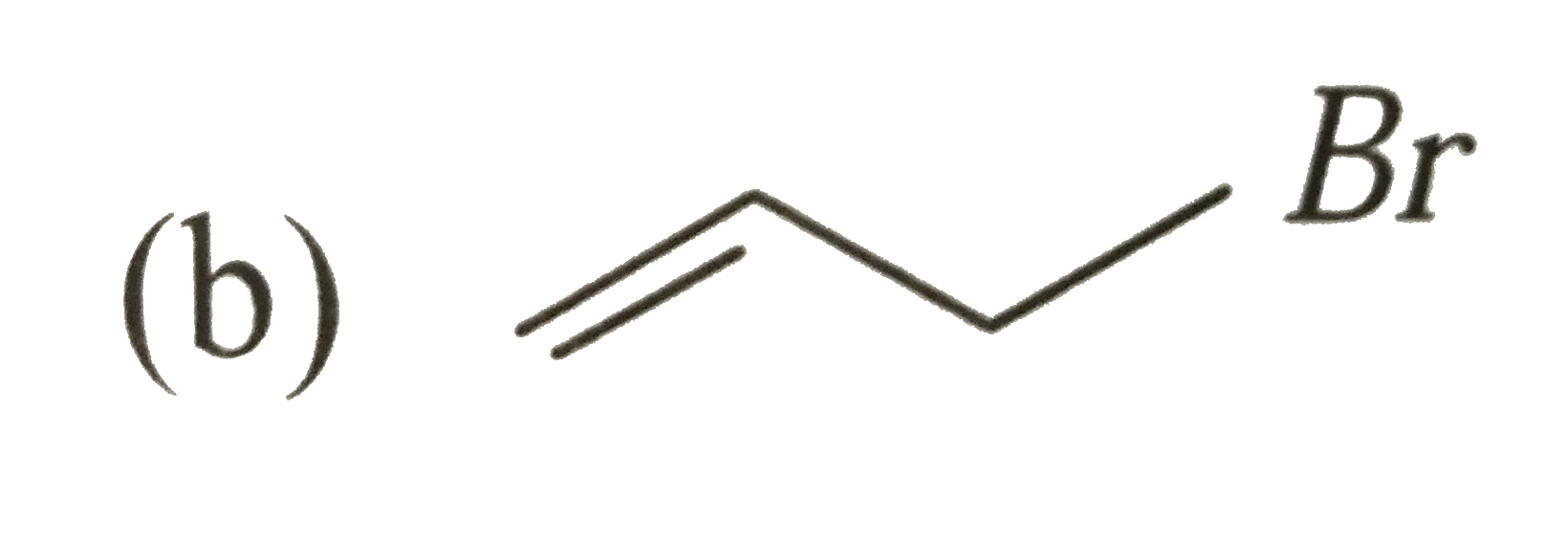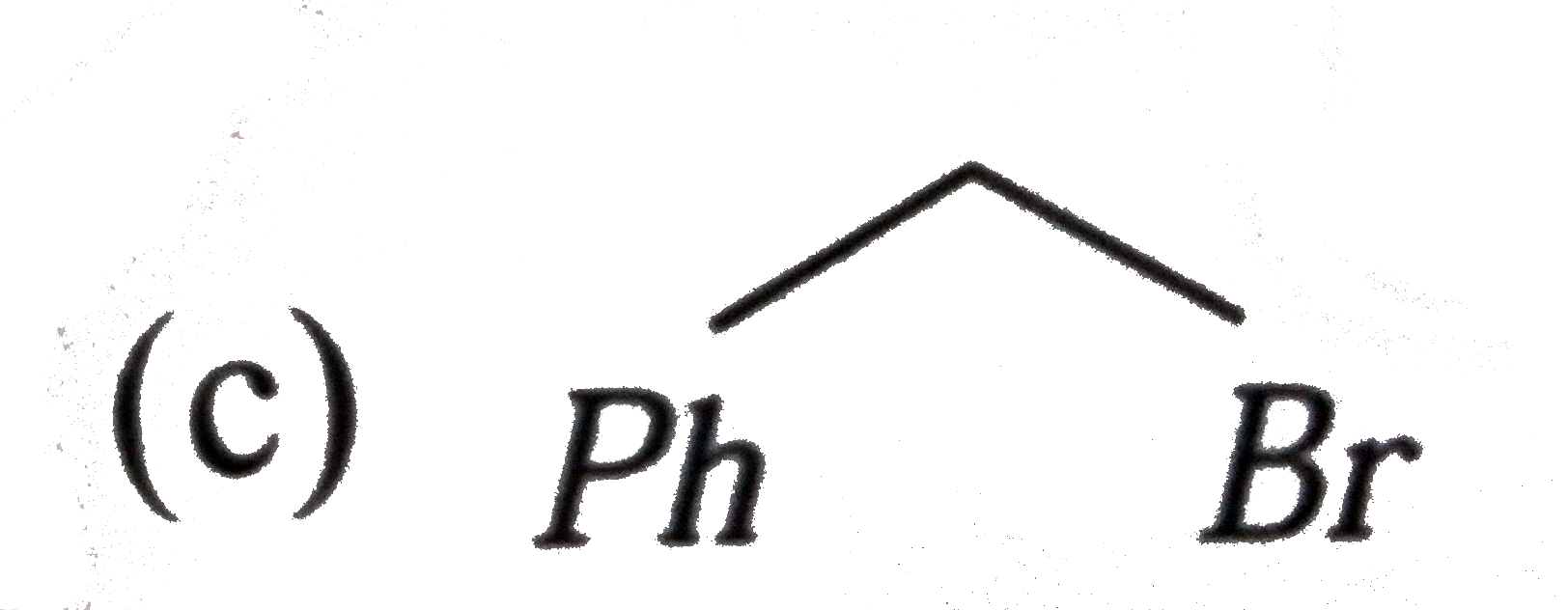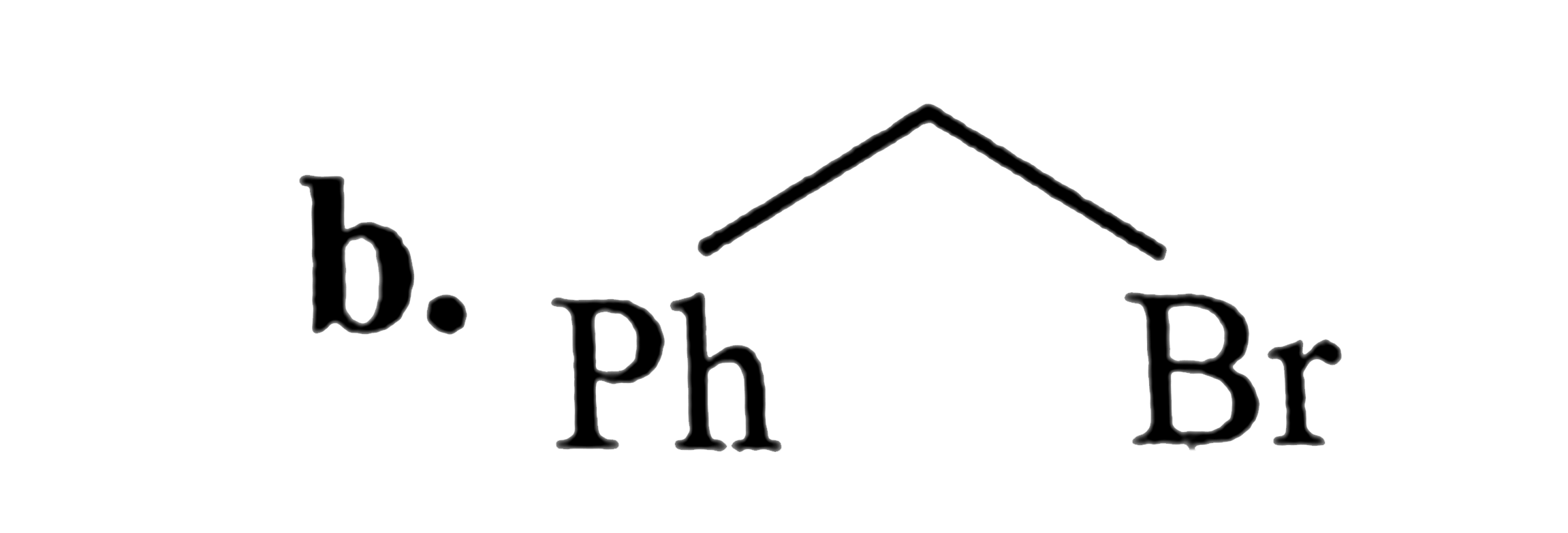Velocity of the SN2 reaction depends on the concentration of the substrate as well as te nucleophile.
The reaction is favoured by strong Nu..ө, and in the presence of polar aprotic solvent, optically active halides give walden inversion by SN2 mechanism. the presence of hetro group (atom as β−C atom, unsaturation at β−C, and ⎛⎜
⎜⎝−O∣∣C−⎞⎟
⎟⎠ Allyl halides also give SN2 mechanism. EDG at ortho-and para-positions in benzyl halides favours SN1 mechanism, whereas EWG favours SN2 mechanism.
Q. Which of the following will give SN2 mechanism
MeBr


All of these
The correct Answer is:D
To determine which compounds will undergo the SN2 mechanism, we need to analyze the conditions and characteristics that favor this type of reaction. Here’s a step-by-step breakdown of the reasoning based on the information provided:
Step 1: Understand the SN2 Mechanism
The SN2 (Substitution Nucleophilic Bimolecular) mechanism is characterized by a single concerted step where the nucleophile attacks the substrate and displaces the leaving group simultaneously. The rate of the reaction depends on the concentrations of both the substrate and the nucleophile.
Hint: Remember that SN2 reactions are favored by strong nucleophiles and occur in a single step.
Step 2: Identify the Role of Nucleophiles
The SN2 mechanism is favored by strong nucleophiles. A strong nucleophile is one that can effectively donate its electron pair to form a bond with the substrate.
Hint: Look for nucleophiles that are either negatively charged or have lone pairs available for bonding.
Step 3: Consider the Structure of the Substrate
The structure of the substrate plays a crucial role in determining whether SN2 will occur. Primary substrates (1°) are more favorable for SN2 due to less steric hindrance, while tertiary substrates (3°) are generally not suitable for SN2 due to steric crowding.
Hint: Identify whether the halide is primary, secondary, or tertiary. Primary substrates favor SN2.
Step 4: Analyze the Solvent Effects
Polar aprotic solvents (like DMF or DMSO) stabilize the nucleophile without forming strong hydrogen bonds, which enhances the nucleophilicity and thus favors SN2 reactions.
Hint: Check if the reaction conditions mention the use of polar aprotic solvents.
Step 5: Evaluate the Presence of Electron-Withdrawing and Electron-Donating Groups
Electron-withdrawing groups (EWGs) stabilize the transition state of SN2 reactions, while electron-donating groups (EDGs) can favor SN1 mechanisms, especially in benzyl halides.
Hint: Look for the presence of EWGs that could stabilize the transition state for SN2.
Step 6: Analyze the Given Options
Now, let’s analyze the specific compounds mentioned in the question to determine which will undergo the SN2 mechanism:
1. Methyl Bromide (CH3Br): This is a primary halide and will favor SN2 due to low steric hindrance.
2. Allyl Bromide (C3H5Br): The presence of the double bond and the allylic position makes it suitable for SN2.
3. Phenyl Bromide (C6H5Br): While phenyl groups can complicate SN2, the presence of the bromine can still allow for SN2 under certain conditions.
4. All of the above: Since all the above compounds can potentially undergo SN2 reactions under the right conditions.
Conclusion
Based on the analysis, the correct answer is that all the mentioned compounds can undergo the SN2 mechanism.
Final Answer: All of the above compounds will give SN2 mechanism.
The SN2 (Substitution Nucleophilic Bimolecular) mechanism is characterized by a single concerted step where the nucleophile attacks the substrate and displaces the leaving group simultaneously. The rate of the reaction depends on the concentrations of both the substrate and the nucleophile.
The SN2 mechanism is favored by strong nucleophiles. A strong nucleophile is one that can effectively donate its electron pair to form a bond with the substrate.
The structure of the substrate plays a crucial role in determining whether SN2 will occur. Primary substrates (1°) are more favorable for SN2 due to less steric hindrance, while tertiary substrates (3°) are generally not suitable for SN2 due to steric crowding.
Polar aprotic solvents (like DMF or DMSO) stabilize the nucleophile without forming strong hydrogen bonds, which enhances the nucleophilicity and thus favors SN2 reactions.
Electron-withdrawing groups (EWGs) stabilize the transition state of SN2 reactions, while electron-donating groups (EDGs) can favor SN1 mechanisms, especially in benzyl halides.
Now, let’s analyze the specific compounds mentioned in the question to determine which will undergo the SN2 mechanism:
2. Allyl Bromide (C3H5Br): The presence of the double bond and the allylic position makes it suitable for SN2.
3. Phenyl Bromide (C6H5Br): While phenyl groups can complicate SN2, the presence of the bromine can still allow for SN2 under certain conditions.
4. All of the above: Since all the above compounds can potentially undergo SN2 reactions under the right conditions.
Based on the analysis, the correct answer is that all the mentioned compounds can undergo the SN2 mechanism.
Topper's Solved these Questions
- HALOGEN CONTAINING COMPOUNDBook:ERRORLESS Chapter:HALOGEN CONTAINING COMPOUNDExercise:Critical Thinking (Integer Type Question)
Explore 4 Videos
- HALOGEN CONTAINING COMPOUNDBook:ERRORLESS Chapter:HALOGEN CONTAINING COMPOUNDExercise:Critical Thinking (Matrix match type Question)
Explore 1 Video
- HALOGEN CONTAINING COMPOUNDBook:ERRORLESS Chapter:HALOGEN CONTAINING COMPOUNDExercise:Critical Thinking (Reasoning type Questions)
Explore 2 Videos
- GENERAL ORGANIC CHEMISTRYBook:ERRORLESS Chapter:GENERAL ORGANIC CHEMISTRYExercise:Matrix Match type questions
Explore 4 Videos
- HYDROCARBONBook:ERRORLESS Chapter:HYDROCARBONExercise:JEE SECTION (Matrix Match type questions)
Explore 6 Videos
Similar Questions
SN2 reaction is a bimolecular reaction which takes places by the formation of T.S. Veolcity of the reaction depends on the concentration of the substrate as well as the nucleophile.
The reaction is favoureed by strong Nuo− and in the presence of polar aprotic sovlent, optically active halides give. Walken inversion by SN2 mechanism. The presence of hero group (atom) at β−C atom, unsaturation at β−C and ⎛⎜ ⎜⎝−O∣∣C−⎞⎟ ⎟⎠ group at α−C atomn favor SN2 mechanism.
Allyl halides and benzyl halides give SN1 and SN2 reactions. Allyl halides alos give SN2 mechanism EDG at ortho- and para- postions in benzyl halides favors SN1 mechanism, wheras EWG favors SN2 mechanism.
Which of the following will give SN2 mechanism?
View SolutionSN2 reaction is a bimolecular reaction which takes places by the formation of T.S. Veolcity of the reaction depends on the concentration of the substrate as well as the nucleophile.
The reaction is favoureed by strong Nuo− and in the presence of polar aprotic sovlent, optically active halides give. Walken inversion by SN2 mechanism. The presence of hero group (atom) at β−C atom, unsaturation at β−C and ⎛⎜ ⎜⎝−O∣∣C−⎞⎟ ⎟⎠ group at α−C atomn favor SN2 mechanism.
Allyl halides and benzyl halides give SN1 and SN2 reactions. Allyl halides alos give SN2 mechanism EDG at ortho- and para- postions in benzyl halides favors SN1 mechanism, wheras EWG favors SN2 mechanism.
Which of the following will give SN1 reaction?
View Solution
Knowledge Check
Velocity of the SN2 reaction depends on the concentration of the substrate as well as te nucleophile.
The reaction is favoured by strong Nu..ө, and in the presence of polar aprotic solvent, optically active halides give walden inversion by SN2 mechanism. the presence of hetro group (atom as β−C atom, unsaturation at β−C, and ⎛⎜ ⎜⎝−O∣∣C−⎞⎟ ⎟⎠ Allyl halides also give SN2 mechanism. EDG at ortho-and para-positions in benzyl halides favours SN1 mechanism, whereas EWG favours SN2 mechanism.
Q. Which of the following will give Walden inversionAC4H9−CHD−BrB C
C DAll of these
DAll of theseSN2 reaction is a bimolecular reaction which takes places by the formation of T.S. Veolcity of the reaction depends on the concentration of the substrate as well as the nucleophile.
The reaction is favoureed by strong Nuo− and in the presence of polar aprotic sovlent, optically active halides give. Walken inversion by SN2 mechanism. The presence of hero group (atom) at β−C atom, unsaturation at β−C and ⎛⎜ ⎜⎝−O∣∣C−⎞⎟ ⎟⎠ group at α−C atomn favor SN2 mechanism.
Allyl halides and benzyl halides give SN1 and SN2 reactions. Allyl halides alos give SN2 mechanism EDG at ortho- and para- postions in benzyl halides favors SN1 mechanism, wheras EWG favors SN2 mechanism.
Which of the following will give Walden inversion ?AC4H9−CHD−Br,B C
C DAll
DAllSN2 reaction is a bimolecular reaction which takes places by the formation of T.S. Veolcity of the reaction depends on the concentration of the substrate as well as the nucleophile.
The reaction is favoureed by strong Nuo− and in the presence of polar aprotic sovlent, optically active halides give. Walken inversion by SN2 mechanism. The presence of hero group (atom) at β−C atom, unsaturation at β−C and ⎛⎜ ⎜⎝−O∣∣C−⎞⎟ ⎟⎠ group at α−C atomn favor SN2 mechanism.
Allyl halides and benzyl halides give SN1 and SN2 reactions. Allyl halides alos give SN2 mechanism EDG at ortho- and para- postions in benzyl halides favors SN1 mechanism, wheras EWG favors SN2 mechanism.
Which of the following will gives SN2 mechanism gtAEtBrB C
C DAll
DAll
Which of the following nucelophiles favours SN2 mechanism ?
View SolutionWhich of the following alkyl halides is hydrolysis by SN2 mechanism?
View SolutionWhich of the following alkyl halides is hydrolysed by SN1 mechanism?
View SolutionA dextro- rotatory optically active alkyl halide undergoes hydrolysis by SN2 mechanism. The resulting alcohol is :
View SolutionOptically active alkyl halides under going SN1 mechanism leads to:
View Solution

